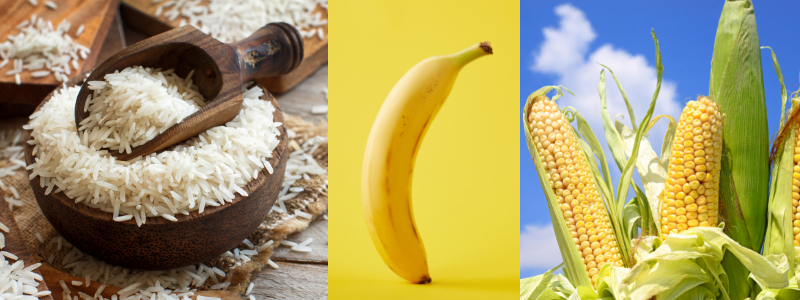
Vitamin A is crucial to maintaining good health and preventing various health issues. According to the premier World Health Organization (WHO), Vitamin A deficiency (VAD) is a noteworthy public health concern, especially in low-income countries in Africa and South-East Asia. VAD is the primary cause of preventable blindness in children and increases the risk of contagious infections, resulting in disease and even death. Focusing on foods rich in vitamin A sources, such as leafy vegetables, tomato, mango, carrot, eggs and fish is essential to combat this deficiency. In this blog, let’s explore vitamin A’s significance and the potential benefits of vitamin A-rich rice, banana, and maize.
Vitamin A-Rich Rice
One of the remarkable innovations in addressing vitamin A deficiency is Golden Rice, a genetically engineered Rice with beta carotene, a precursor to vitamin A. This biofortified Rice is critical in combating the devastating consequences of widespread vitamin A deficiency in developing and nations and vulnerable populations. In many cultures, children are weaned on rice gruel, and if they do not receive enough beta-carotene or vitamin A rich foods during this crucial period, they may suffer long-term consequences. Golden Rice aims to provide a sustainable solution to this problem by fortifying rice with essential nutrients, making it a valuable addition to the diet of vulnerable populations.
Vitamin A-Rich Banana
Bananas, a widely consumed fruit cultivated in tropical and subtropical regions, are a significant source of nutrients for many communities. Researchers have made significant strides in the field of biotechnology by developing “biofortified” bananas that are rich in provitamin A. By combining genes from a species of banana high in provitamin A with a high-yielding Cavendish banana, scientists have created bananas that can effectively address vitamin A deficiency. These nutritionally rewarding bananas have the potential to save hundreds of thousands of children’s lives, since it forma a major part of the infant diet.
Vitamin A-Rich Maize
Maize, the world’s third most commonly consumed cereal grain, holds great promise in combating vitamin A deficiency. Maize flour and corn meal, widely consumed in many regions, can be fortified to enhance their nutritional value. Provitamin A carotenoid biofortified “orange” maize, developed through selective breeding, increases beta-carotene, beta-cryptoxanthin, and zeaxanthin in the endosperm. Studies have shown that vitamin A-biofortified orange maize significantly improves visual functions in children with vitamin A deficiency. This food-based approach to combating deficiency underscores the importance of integrating vitamin A-rich maize into daily diets.
The societal impact of vitamin A-rich rice, maize, and banana
Vitamin A is essential for maintaining balanced vision and is vital in many physiological processes of the human body. It is critical for fetal development, immune response, and overall growth, which makes Vitamin A essential for mothers’ and children’s well-being and survival.
Agricultural biotechnology and genetic engineering advancements have paved the way for innovative solutions to the global issue of VAD. Golden Rice, vitamin A-rich bananas, and biofortified maize offer promising ways to combat vitamin A deficiency and improve the overall health of vulnerable populations. As we continue to explore the potential advantages of these nutrient-rich crops, it becomes clear that vitamin A is essential for individual health and building a healthier society. Let us explore the profound effects of these vitamin A-rich foods on societies.
- Enhancing Food and Nutrition Security
Fortifying these crops with essential nutrients makes them valuable sources of vitamins and minerals, reducing the risk of malnutrition and related health issues. Improved food security ensures that communities have access to a diversified and nutritious diet, contributing to better overall health, cognitive development, and economic productivity.
- Empowering Local Farmers and Agricultural Sustainability
The cultivation and promotion of vitamin A-rich rice, maize, and banana not only benefits the health of communities but also empowers local farmers. Farmers can produce nutrient-rich foods in high demand by growing biofortified crops, leading to increased income and economic growth.
- Economic Growth and Poverty Alleviation
Healthy populations are more productive and better equipped to participate in the workforce, leading to increased economic output and community prosperity. Moreover, improved health reduces healthcare costs and breaks the cycle of poverty.
- Improving Child Survival and Development
Children are among the most vulnerable to the consequences of vitamin A deficiency. The integration of vitamin A-rich rice, maize, and banana in children’s diets can significantly impact child survival and development. Improved access to essential nutrients during early childhood ensures proper growth, strengthens the immune system, and reduces the risk of debilitating health issues.
In conclusion, the societal impact of vitamin A-rich rice, maize, and bananas is far-reaching and transformative. From combating vitamin-A deficiency to promoting economic growth and food security, these nutrient-dense crops play a significant role in improving health conditions throughout the world. By harnessing the potential of biotechnology and agricultural innovation, we can continue to advance the availability and accessibility of these and many other , ultimately leading to healthier, more resilient, and prosperous societies.
